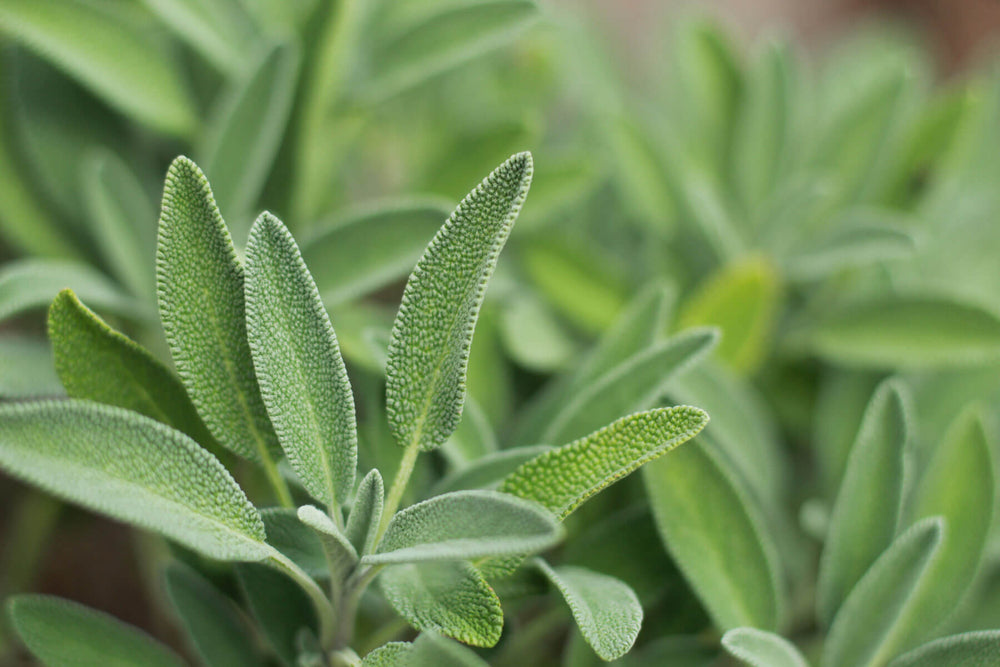Common sage takes the form of a low shrub that can be wider than it is tall. The soft gray-green foliage is great in pots or the garden. Consider planting and growing sage in a container with rosemary, basil, and other Mediterranean herbs for a fragrant mix. While cooks appreciate the distinctive taste and scent of sage, gardeners also enjoy its velvety, evergreen foliage, and delicate blooms. When choosing sage plants to grow, be sure to look for those from Bonnie Plants®, the company that has been helping home gardeners succeed for over a century.
Quick Guide to Growing Sage
- Plant sage during the cool days of spring or fall. This fragrant culinary herb is a great option to grow in containers or out in your garden bed.
- Space sage plants 18 to 24 inches apart in an area that gets plenty of sunlight and has rich, well-drained soil with a pH of 6.5 to 7.0.
- If planting in a garden bed, give your native soil a boost of nutrients by mixing in several inches of aged compost or other rich organic matter.
- Check soil moisture every few days and water once the top inch of soil becomes dry.
- Feed regularly with a water-soluble plant food to make the most of your growing efforts.
- Annual and perennial sage are harvested differently, so harvest according to your plant type.
Soil, Planting, and Care
If you live in zones 5 to 8, your sage will grow as a hardy perennial. However, in the humid climates of zones 9 and farther south, sage is usually an annual, as it does not easily tolerate summer heat and humidity. Set out plants in spring or fall, planting seedlings 18 to 24 inches apart. Choose a sunny spot in well-drained soil with a pH between 6.5 and 7. If you have clay soil, add sand and organic matter to lighten up soil and provide better drainage, or make things simple by mixing in a few inches of aged compost-enriched Miracle-Gro® Performance Organics® All Purpose In-Ground Soil. Sage also grows quite well in pots. Fill containers with Miracle-Gro® Performance Organics® All Purpose Container Mix to provide an excellent environment for root growth. For best results, pair great soil with just the right plant food. Feed sage regularly with a water-soluble fertilizer like Miracle-Gro® Performance Organics® Edibles Plant Nutrition, following label directions.
You can also grow sage indoors. One easy way to plant it in a water-based (aka hydroponic) system like the Miracle-Gro® Twelve™ Indoor Growing System. It's simple to use, even for beginners, and provides sage and other herbs and greens with a truly nurturing growing environment. Plants grow directly under a grow light, in water that circulates around the roots to deliver moisture, nutrition, and air.
Prune plants back in early spring every year, cutting out the oldest growth to promote new growth. You will begin to see little pink or purple flowers in late spring. Even with pruning, plants can get woody and stop producing lots of branches after 3 to 5 years. At this point, you may want to dig up your original and plant a new one.
Troubleshooting
Mildew is a problem for sage, so thin plants regularly to encourage air circulation. Watch carefully on the hottest, most humid summer days. You can also mulch with pebbles to help keep the area immediately around the leaves dry. The moisture from pebbles evaporates quickly compared to organic mulches.
Harvest and Storage
In areas in which it is perennial, harvest sage only lightly during the first year. In subsequent years, harvest sage as you need it, year-round. Cut an entire stem if desired, or just pinch a leaf at a time. To give new foliage time to fully mature, leave 2 months between your last big harvest and the first frost of the season. Dry harvested sage by hanging bunches of stems upside-down. Strip the dry leaves from the stem and store in an airtight container. Keep the flowers on the stems to cultivate pretty pods that work well in dried herb arrangements.






 Herbs
Herbs
 Vegetables
Vegetables
 Fruit
Fruit
 Flowers
Flowers
 Succulents
Succulents


